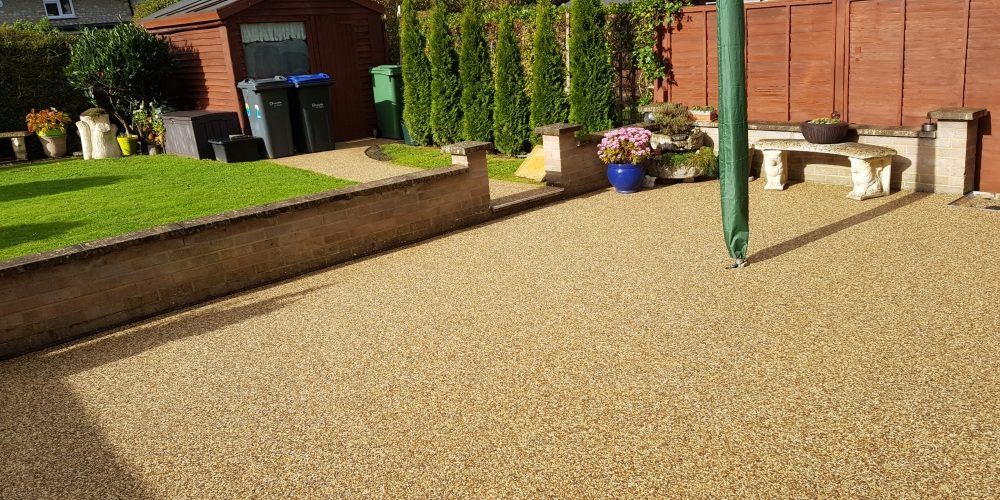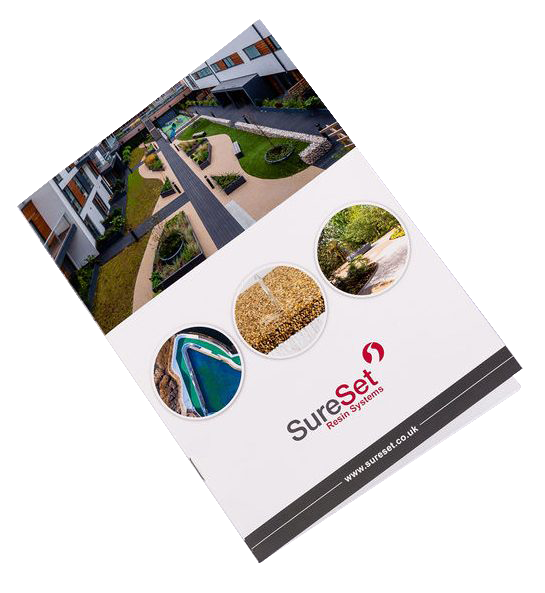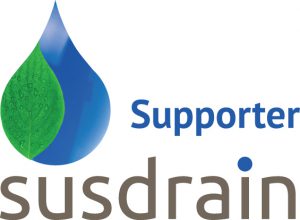
How to install a resin bound DIYPack
Firstly, we would suggest reading through the instructions before you plan a day to use your DIYPack. Then you can ensure you have all the extra equipment needed before you begin and feel prepared on the day you plan to use it.
Extras equipment needed tends to include things like
- Spare gloves
- Masking tape for edges
- Large tarpaulin or sheets to protect the areas you plan to mix the aggregate.
- A handheld paddle drill mixer – to help evenly combine the resin and aggregates together, we only provide the whisk head.
- Hand float (the first one is free with the below code)
Mixing the resin together
When you are ready to lay your DIYPack, the two pouches of resin - Component I and Component P - must mix together.
Wearing your provided gloves, open by tearing off the top of each pouch between the tear-off darts and empty the entire contents of each pouch into one of the mixing tubs provided. It is extremely important to ensure that each pouch is completely empty.
Tip: use the resin tub no more than four times for mixing before discarding it.
Using the spatula provided, thoroughly mix the two resin components together; failure to do so can lead to a loss of durability of the final product. Once fully mixed the resin binder should be a consistent creamy colour.
Tip: tilt the resin mixing tubs during the mixing process.
Mixing the resin and aggregate in a bucket
Using this method, mix only one DIYPack at a time.
Empty the large bag of aggregate into the 40ltr mixing bucket provided and add the resin you have just mixed, ensuring all the resin has been scraped from the tub using the spatula provided.
Using a whisk (handheld paddle drill not provided), mix the aggregate and resin together. Ensure all the aggregate is fully coated in resin and that the resin is consistently distributed throughout the mixture.
Tip: Make sure the whisk scrapes along the bottom and sides of the bucket to ensure all materials have been whisked and there are no dry patches.
After mixing, empty the bag of provided SureSand over the material and whisk until evenly distributed throughout the mix. Ensure that the mixture doesn’t contain any lumps.
Mixing the resin and aggregate in a forced action mixer
If you have a large floor standing ‘forced action mixer’ we would suggest buying our TradePacks, as they are designed to be mixed using a forced action paddle mixer. However the method for a DIYPack is the same - You can mix up to three times the amount of resin in these simply because a floor-standing mixer holds more material than a bucket, you can empty up to three 25kg bags of aggregate into a mixer with a capacity of over 100ltrs (check what capacity your mixer hold).
With a forced action mixer you empty the required combination of resin and aggregate into the mixer, ensuring all the resin has been scraped from the tubs using the spatula provided. Mix until all the aggregate is evenly coated with resin. This should take around 30-40 seconds.
Once evenly and thoroughly mixed, empty in the required bags of provided SureSand and continue to mix until fully distributed. The mix must be completely free from any clumps.
Tip: it is important to record how long the first mix takes and ensure that all subsequent mixes are done for the same length of time. If any material is mixed for a long or short amount of time a colour change may occur.
Empty the material into a wheelbarrow lined with a plastic sheet and transport it to the point of installation.
Laying the SureSet
Levelling and floating: pour the mixed materials along a narrow strip so that work progresses in a series of strips across the area to be laid. Level out the material with a squeegee or straight edge (not provided) slightly higher than the finished depth required and start ‘floating’ (the first float is free with below code) the SureSet resin bound by pushing the mixture around to make it flat.
Tip: use a smooth continuous motion with long, side to side and back and forth sweeps of the float. Apply a low angle of attack with firm but light pressure to ensure undulations and marks on the surface are removed.
Do not ‘over float’, as this can darken the surface, producing variations in appearance. Keep the float well lubricated with white spirit – ideally clean and lubricate after every 2-3 strokes.
Sprinkling: after floating, carefully cast the grit cast over the surface at a rate of two small handfuls per m² (80gms/m²). Take care to avoid cast marks or lumps at a rate of 2 small handfuls per m² (80gms/m²). This helps give an immediate slip-resistant finish.
The amount of grit cast provided is sufficient for 30m² at the recommended coverage rate.
Forming a ‘day joint’: when working over more than one day a day joint in the surface is usually necessary. These should be planned into your installation considering the aesthetics and geometry of the area to be surfaced. This can be done with a:
Temporary joint, which is a timber batten the same height or slightly less than the depth of the SureSet, which is removed the following day. Fresh material can then be laid up against the existing edge the next day.
Permanent joint, which is an aluminium or stainless steel edge (available from the SureSet shop).
Or a permanent movement joint, which is made from aluminium or stainless steel and also available from SureSet through our online shop.
All the extra’s you need can be bought online through SureSet.
- Squeegee can be bought here.
- Paddle drill can be bought separately here.
- A forced action mixer can be bought here.
- Edging can be bought here.
- Hand float here.
Free resin bull hand float code...
SureSet is the latest distributor to work with The Resin Bull. We are delighted to offer their dual handled floats in 3 sizes now available to purchase on our online shop www.suresetshop.com.
Resin Bull Floats are also on offer when they are purchased alongside our DIY & Trade products such as ProResin, TradePack, DIY Pack, and DIY Kits.
Use the discount code of RB25 for 25% off your Resin Bull Float. (Only valid on the first float added to your order and when purchased alongside our DIY or Trade product).
Watch what you can achieve with a DIYPack - Play video.
FAQ’s
How long does it take for the material to cure?
Once mixed, the SureSet resin typically takes up to 24 hours to cure and go hard, depending on the air and surface temperatures. If the material has not cured after 48-hours please contact SureSet for advice.
What happens if I don’t mix it properly?
If the resin and aggregate are not mixed thoroughly and the aggregate particles are not equally coated, it can result in early failure of the product. There is also a risk of a build-up of resin and fine aggregates which can cause foaming or whitening and blisters in the cured surface.
What happens if I can’t finish my project in one day?
When working more than one day it is normally necessary to install/allow for a day joint within the SureSet surface. This can be done by temporarily forming a neat edge at the intended place for the joint using a timber batten which can then be removed and fresh material laid against the previous installation the following day. A permanent edge can be made using aluminium square edge profiles which are available from SureSet.
How long do I have to work with the material?
Once mixed you have approximately 10-20 minutes of working time per pack. After this time the material will start to stiffen and any further use of the float may mark the surface.
What edging can I use?
SureSet can be laid up against almost any type of edge, such as brick pavers, timber edging, stainless steel or aluminium edging, lawn edging, or directly up against walls.
Do I need to protect the edging?
It is essential to mask all edging to reduce the risk of staining from the SureSet resin and associated tools.
Is there a shelf life on the resin if not used right away?
Providing your DIYPack is stored in a cool, dry place, it will last for up to three months. Please remember that this product is bespoke and the cure rate of the resin is optimised for the season it is supplied in.
What must the weather conditions be?
Weather conditions should be dry, and above 50C, with a relative humidity of less than 85%.
What happens if water is spilled onto or it rains before the surface has fully cured?
SureSet should not be used if the surface on which it will be laid is wet if it is raining, or it is forecast to rain before it will be fully cured (typically up to 24hrs depending on ambient temperature).
If water does come into contact with the uncured material there is a very high likelihood that it will damage it and cause it to change appearance due to the foaming of the resin. This effect can only be remedied by replacing the affected area.
If rain or water is likely to come into contact with the surface before it has fully cured then we recommend covering the surface with a waterproof sheet; ensuring that it is supported so that it does not come into direct contact with the surface and there is plenty of ventilation to reduce the risk of moisture collecting under the cover.
Read more FAQs on DIYPack.
Enquire








